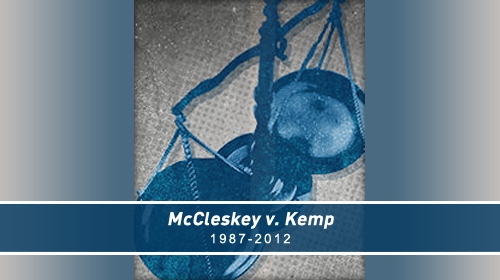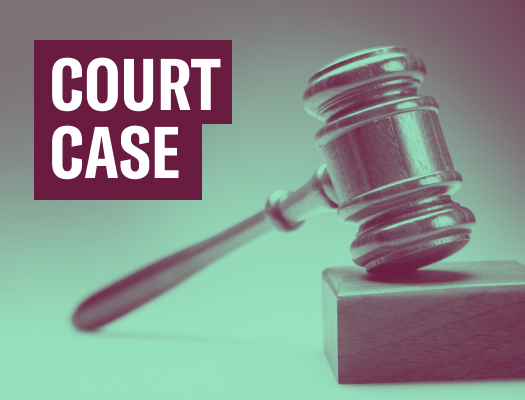
April 22 marks the 25th anniversary of the Supreme Court decision in McCleskey v. Kemp, in which the Court ruled that a defendant cannot rely upon statistical evidence of systemic racial bias to prove his death sentence unconstitutional, no matter how strong that evidence may be. McCleskey has been roundly condemned as a low point in the quest for equality that begs to be revisited. To mark the occasion, every day this week the ACLU Blog of Rights will feature a new post about McCleskey and its legacy. You can read all the posts here, and visit mccleskeyvkemp.com to learn more.
Levon "Bo" Jones spent 14 years on North Carolina's death row for a murder he did not commit, before being exonerated in 2008. Police sought to charge Jones, who is Black, with the murder of a white bootlegger named Leamon Grady, despite obvious flaws in the case and a far more compelling white suspect.
Jones' case is illustrative of a large problem. We know there is a strong link between race and who ends up on death row: studies across the country have repeatedly documented that Black people convicted of killing white people are far more likely to be sentenced to death than white people convicted of killing black people. So perhaps it should come as no surprise that there is also a strong link between race and wrongful convictions.
Nationwide, Black defendants are more likely than their white counterparts to be wrongfully convicted, and defendants charged with crimes against white victims are far more likely to be erroneously convicted than defendants charged with crimes involving nonwhite victims. Despite the fact that there are far more Black homicides with Black victims, an overwhelming 76 percent of all death row exonerees were wrongfully convicted of the murders of white victims.
This pattern is apparent here in North Carolina's death row. Of the seven death row inmates exonerated since North Carolina reinstated the death penalty in 1977, five are Black, and six are nonwhite. All seven exonerees — or 100 percent of North Carolina's death row exonerees — were in cases with white victims.
The explanations for this bias span every stage of the charging and conviction process — from racially biased police investigation and arrest policies, to the harsher treatment and greater suspicion defendants of color face — particularly when charged with crimes against white victims, to unconscious biases at trial and sentencing.
These facts are ones that ACLU client Jones understands all too well. In Jones' case, the key witness against him went to the police three years after the crime, and gave five wildly inconsistent stories about Jones' supposed involvement. The witness had a long history of petty crime and a host of credibility problems. It is hard to imagine police taking seriously this kind of evidence if the defendant were a wealthy white community member. Indeed, the police did not charge the white suspect, even though under the suspect's own self-serving story, he broke into Grady's home and stepped over Grady's body to steal beer from Grady's refrigerator.
The racially biased treatment of Jones did not end with the police. His own trial lawyers never took seriously the possibility that he was innocent, and thus never investigated the case. They failed, for example, to walk over to the district attorney's office to get the contradictory statements made by the witness or to investigate her credibility problems. Instead, they simply focused on trying to convince Jones to plead guilty of a crime he did not commit. At trial, a white judge presided over Jones's case and an all-white jury convicted him and sentenced him to death.
Jones also knows too well the steep cost of wrongful convictions. North Carolina has never compensated him for all of his years behind bars, leaving him and his family to bear the costs alone. He has struggled to find permanent work, as many employers see his murder arrest on a criminal background search and decline to even give him an interview. Instead of a job with retirement benefits or vacation pay, Jones must spend long, hard hours doing day labor work when he can find it. He also missed his daughter's childhood. His daughter was a baby when he was arrested, and was a young adult when he was released from prison. His dear older sister, who believed in his innocence and championed his case all along, passed away last year. He had only few years with her after his release from prison.
The most important payment we can make on the debt we owe Jones and other wrongfully convicted defendants is to break the link between race and the death penalty. Twenty-five years ago this week the United States Supreme Court turned its back on justice for the death penalty when it held in McCleskey v. Kemp that systemic evidence of racial bias in capital sentencing was insufficient to show a constitutional violation.
Thankfully, the North Carolina legislature took an enormous step to reverse the damage of McCleskey when it passed the Racial Justice Act, which allows capital defendants to use statistical evidence of systemic bias in the death penalty to challenge their death sentences. Other states should follow suit.
Learn more about race and the death penalty: Sign up for breaking news alerts, follow us on Twitter, and like us on Facebook.




